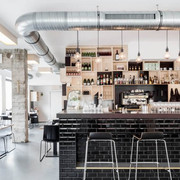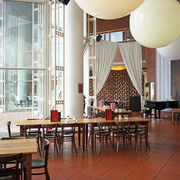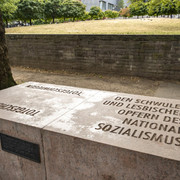Photos & Map
How would you like to arrive?
Details
Useful Information
Nearby
He was known as a lover of splendid uniforms, with a passion for the military, the last German Emperor, Emperor Wilhelm II. His full name was Friedrich Wilhelm Viktor Albert of Prussia. One day, it is said, while inspecting the navy, he noticed that some officers were not wearing his preferred uniform. He immediately requested the officers to visit the dressing room and reappear in the correct uniform.
While the officers were absent, the Emperor himself delivered a speech on the importance of discipline and appearance as an expression of inner attitude. Emperor Wilhelm II had a strong understanding of the power of symbolism, and his autocratic and unyielding stance repeatedly led to domestic or international conflicts during his reign, up to the First World War.
With his forced exile and the beginning of the Weimar Republic, the German monarchy ended – Emperor Wilhelm II was forced to abdicate, went into exile in the Netherlands, and lived there until his death in 1941.
In close proximity, the multi-interpretative outdoor artwork Ma’alot by the renowned Israeli artist Dani Karavan creates further associative links to the intersections with the Nazi genocides in Germany. You can experience the full impact of this at Heinrich-Böll-Platz, right next to the Museum Ludwig near the Hohenzollern Bridge.
The monument, like the other statues on the Hohenzollern Bridge, symbolizes the power and influence of the Hohenzollerns. It also serves as a reminder of the era before the First World War and the associated social and political upheavals in Germany.
On the Hohenzollern Bridge, you can see four of these rulers as equestrian statues – besides Wilhelm II, the statue of King Friedrich Wilhelm III, that of Emperor Friedrich III, as well as that of Emperor Wilhelm I. Can you distinguish the statues? Then you probably have solid knowledge about the Prussians.
While the officers were absent, the Emperor himself delivered a speech on the importance of discipline and appearance as an expression of inner attitude. Emperor Wilhelm II had a strong understanding of the power of symbolism, and his autocratic and unyielding stance repeatedly led to domestic or international conflicts during his reign, up to the First World War.
Wilhelm II: Beneficial for the Economy, Challenging for Diplomacy
With the abdication of Emperor Wilhelm II in 1918, both his reign since 1888 and the German Empire, as well as the First World War, came to an end. Under Wilhelm II, Germany experienced an enormous economic upswing; however, the impulsive nature of the Emperor often contributed to diplomatic tensions with other powers in Europe, particularly with Great Britain and France. His political missteps eventually led to the destabilization of Europe and the outbreak of the First World War.With his forced exile and the beginning of the Weimar Republic, the German monarchy ended – Emperor Wilhelm II was forced to abdicate, went into exile in the Netherlands, and lived there until his death in 1941.
Scene of Current Racism Debates: June 2020
The equestrian statue of Wilhelm II became a focal point for contemporary "Black Lives Matter" debates. During the night of June 24, 2020, unknown individuals carried out a paint attack on the monument and placed posters and banners around it addressing the theme "The Kaiser and Colonization." The fact that Kaiser Wilhelm II was targeted is not coincidental, given his prominent colonial policies, which culminated in 1904 in one of the first devastating genocides of modern times: that of the Herero and Nama. With these facts in mind, this statue, despite its historical significance as a former monument, transforms in hindsight into a modern memorial.In close proximity, the multi-interpretative outdoor artwork Ma’alot by the renowned Israeli artist Dani Karavan creates further associative links to the intersections with the Nazi genocides in Germany. You can experience the full impact of this at Heinrich-Böll-Platz, right next to the Museum Ludwig near the Hohenzollern Bridge.
Equestrian Statue of Kaiser Wilhelm II – One of Four Equestrian Statues
The equestrian statue on the Hohenzollern Bridge, near the cathedral and main station, honors Wilhelm's significance as a central figure in the history of the German Empire. This monument is one of four – alongside Wilhelm II, you will also find the equestrian statue of his father, Emperor Friedrich III, known for his short reign of only 99 days. You will pass all these equestrian statues on a tour to the love locks on the Hohenzollern Bridge.Emperor in Bronze on Granite
The equestrian statue of the last German Emperor is located on the left bank of the bridge and was unveiled in 1911. It was created by the sculptor Louis Tuaillon. The figure, along with the horse, is made of bronze, and the pedestal is made of solid granite. The Emperor sits in a dignified pose on his steed, honored in his symbolic role as a monarch and military leader. The details in the craftsmanship of the uniform and the horse reflect high artisanal quality.The monument, like the other statues on the Hohenzollern Bridge, symbolizes the power and influence of the Hohenzollerns. It also serves as a reminder of the era before the First World War and the associated social and political upheavals in Germany.
Hohenzollern: Dynasty until 1918
The Hohenzollern dynasty ended in 1918. Before the First World War, all kings of Prussia and emperors of Germany came from their lineage, up to the last German Emperor Wilhelm II.On the Hohenzollern Bridge, you can see four of these rulers as equestrian statues – besides Wilhelm II, the statue of King Friedrich Wilhelm III, that of Emperor Friedrich III, as well as that of Emperor Wilhelm I. Can you distinguish the statues? Then you probably have solid knowledge about the Prussians.
Useful Information
Eligibility
for Groups
for Class
for families
for individual guests
Suitable for Pushchair
Payment Options
Entrance Free
Parking facilities
The walk from Cologne main station takes about 3 minutes.
Our recommendations
Nearby










